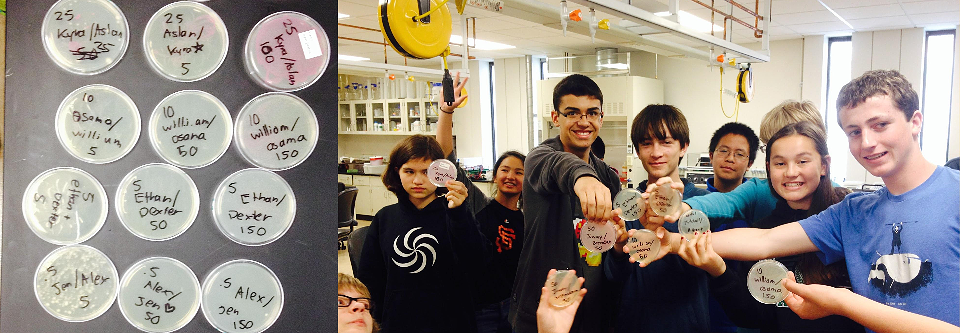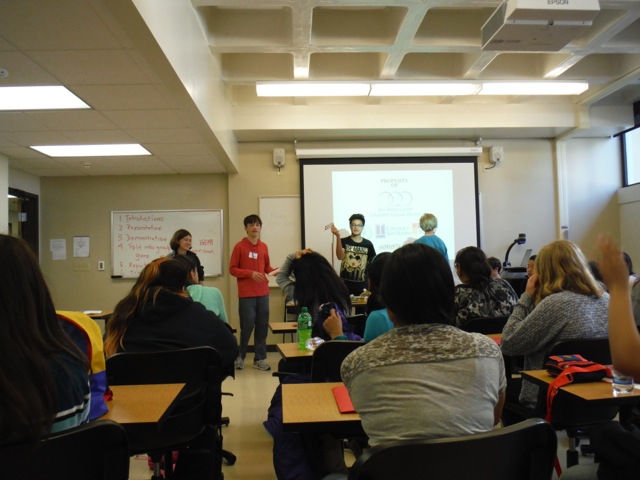Team:Shasta Summit CA
From 2014hs.igem.org
(→Fun!) |
|||
| Line 61: | Line 61: | ||
[http://aslanbnguyen.wix.com/igem#!projects/cm8a Read up here!] | [http://aslanbnguyen.wix.com/igem#!projects/cm8a Read up here!] | ||
| + | |||
| + | |||
| + | == Expanding Your Horizon == | ||
| + | |||
| + | On March 15th the team went to Skyline College to be part of the Expanding Your Horizons program. They introduced future high schoolers to the idea of synthetic biology. They hoped to inspire young women to be more interested in the field of science | ||
| + | |||
| + | [[File:MAGIC.jpg]] | ||
| + | |||
===The Notebook=== | ===The Notebook=== | ||
Revision as of 23:45, 29 April 2014
[http://aslanbnguyen.wix.com/igem The Main Site]
| [http://aslanbnguyen.wix.com/igem Official Team Profile] |
|---|
Contents |
The Team
Professors:
Chris Vulpe of UC Berkeley
Nick Kapp of Skyline College
Students:
Albert Liu
Alex Liu
Aslan Nguyen
Brendan Thompson
Dexter Hamilton
Ethan Bull-Vulpe
Jen Co
Jimmy Lujan
Kyra Newcomb
Mitchell Wong
Osama Hanhan
Sydney Huddleston
William McEachen
[http://aslanbnguyen.wix.com/igem#!team/c46c Show More!]
Our Project
Our iGEM project is to modify bacteria by creating plasmids in order to create a bacteria that detects carbon monoxide. Once they have detected the carbon monoxide, they will release red florescent protein (RFP), which makes the bacteria red, and easy to notice.
[http://aslanbnguyen.wix.com/igem#!projects/cm8a Read up here!]
Expanding Your Horizon
On March 15th the team went to Skyline College to be part of the Expanding Your Horizons program. They introduced future high schoolers to the idea of synthetic biology. They hoped to inspire young women to be more interested in the field of science
The Notebook
Every Tuesday we meet to make progress on our iGEM project. On Thursdays we go to the lab at skyline collage and do laboratory work, at the end of our meetings we discuss the progress we have made, and research new information for our next meeting!
3A Assembly
The team had a blast using the 3A assembly kit. Although with some failures, the team moved on and created a successful transformation!
[http://aslanbnguyen.wix.com/igem#!3a-assembly/c21xx Pictures!]
Results/Conclusions
Over the course of the year we have practiced with bacteria by making transformations and competent cells.
Safety
In the lab at skyline collage we are always supervised by Chris Vulpe (Professor at UC Berkeley), and Nicholas Kapp (Professor at Skyline College).
Although we rarely have lab coats.
Attributions
Who worked on what?
Human Practices
This CO sensor would be useful in many ways:
1. It would not require constant power, this means that you could use it in locations with easy access to power, such as third world countries, underground places/mines, portable/handheld, etc.
2.It would be small and compact, allowing for easy transportation, meaning it could be carried by people everywhere, providing constant protection.
3. It would create a smell, this means that deaf and blind people would be able to be aware of it, as well as allowing people with headphones or ear protection to sniff out CO. This Means that it would have many uses beyond the ordinary electric, roof-bound, carbon monoxide sensor.
Fun!
Error
<forum_subtle />
 "
"

